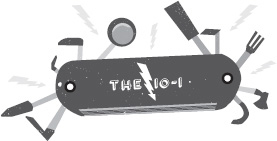Uncle John’s Bathroom Reader Weird Inventions (22 page)
Read Uncle John’s Bathroom Reader Weird Inventions Online
Authors: Bathroom Readers’ Institute


T
he Indian sage Swatmarama wrote, “When the breath wanders, the mind also is unsteady.” While his words may have referred to breathing techniques during yoga, a more recent implication is that those who invest in the Aluminum Facial Spa will have the steadiest minds around. Produced by the Japanese company Akaishi, this aluminum mask covers its wearer’s entire face and uses their own lukewarm breath as a steam facial treatment. The mask fastens around the back of the neck via a Velcro strap using the time-honored hook-and-loop method, and snuggles the jaw—fans of Marvel Comics will find that it falls somewhere between the visages of Iron Man and Dr. Doom. Oh, right, and it’s also bright pink.
Although everyone breathes and sweats differently, the recommended usage time of the mask hovers at around 15 minutes per session, with the
Amazon.com
description for the product—which appears to have been translated from Japanese to English somewhat haphazardly—warning potential buyers, “Please discontinue use if symptoms are itching, and rash appeared in use or after use.” Lastly, while most would reasonably theorize that the mask should be rinsed with water after each use, the company also advises not to clean the mask with a washing machine, dryer, hair dryer, or iron.
P
hil Blizzard had a 10-year-old dog named Dosi who was very friendly and healthy, but terrified by loud noises such as thunderstorms and fireworks displays. Anxiety medicines prescribed by a veterinarian weren’t effective, because they took too long to work; Dosi could sense a storm was coming and would already be freaked out by the time Blizzard could give her a pill.

A trainer suggested noise desensitization, so Blizzard played recordings of thunderstorms. But Dosi wasn’t an idiot. It didn’t work. So what did Blizzard do? He gave Dosi a hug. A permanent hug.
Blizzard developed the Thundershirt—an anxiety-relieving sweater vest for dogs. Simple and easy to slip on, it seemed to cure Dosi of her freakouts immediately. Amazingly, they work for most dogs, and they’re widely available in pet-supply stores now. The concept is similar to swaddling a baby and holding them close to calm them down. The Thundershirt does the same thing for dogs (and cats): hugging them when you can’t get down there and hug them yourself.
A
boiling pot filled with noodles can take anywhere from five to 10 minutes to cook. That’s five to 10 minutes too long, depending on how hungry you are. But thank the Flying Spaghetti Monster: Science has finally given us a faster noodle.
In 2013 Royal Chef, a Japanese food company, released Eight Second Spaghetti. Unfortunately, that name is a bit of a misnomer. Pasta cravers still need to wait for a pot of water to boil first. However, once the water’s bubbling, the pasta does, indeed, cook in just eight seconds. That’s fast enough to make a bowl of instant noodles seem downright slow by comparison. The noodles come in three different varieties: thin, normal, and hefty (they’re normal noodles, but there’s more of them). Prior to cooking, they look like unappetizing bricks, much like the stuff found in a typical package of ramen.
Eight Second Spaghetti is also spendier than your average container of Cup Noodles. The packets cost between 550 and 580 yen. That works out to over $6 per plate. And another drawback? You still need to heat up some spaghetti sauce, too.
S
pray-on weight loss:
CLAmor contains a chemical called Clarinol that’s thought to shrink fat cells. When the clarinol-sprayed food is eaten, it reduces fat on the food and fat that’s already inside the body. It comes in four flavors: butter, olive oil, garlic, and plain. So what is Clarinol? CLAmor’s maker says that it’s a naturally occurring bacterium found in the stomach of cows. It’s harvested from fried ground beef, and also it doesn’t work.
Fat converted to water:
A pill called Phena-Frene/MD sold in the mid-1990s claimed to turn fat into water, which was then flushed from the body by peeing it out. One problem: It’s physically impossible to turn fat into water. The product bombed, despite citing studies from the California Medical School and the U.S. Obesity Research Center, neither of which exists. Phena-Frene was banned in 1997, and also it didn’t work.
Ear-clip your way to a new you:
According to Ninzu, the manufacturer of a device called the B-Trim, weight loss could be attained by clamping this Bluetooth-like object onto the ear. Here’s how it “worked”: The clip put pressure on a nerve ending, which supposedly stopped stomach muscles from moving, signaling to the brain that the stomach was full. This controlled the appetite and resulted in weight loss. The Federal Trade Commission made Ninzu stop selling the B-Trim in 1995 because it didn’t work.
T
he next time someone (probably your grandfather) starts bellyaching about how “if we can send a man to the moon, how come we can’t do [whatever thing he saw on
Star Trek
]?” you can shut him up with three simple words: Spray-On Skin.
Spray-On Skin, developed by Avita Medical Limited, is used in a variety of medical procedures, primarily wound treatment, scar remodeling, and cosmetic surgery, but perhaps most importantly it aids in the treatment and healing of burn victims. And before you even ask, this does not involve keeping spray bottles full of skin at the ready. That would be gross. Cool, but gross.
The process involves harvesting a quantity of healthy skin roughly the size and thickness of one or two postage stamps, which is much less destructive and painful to the patient than a traditional skin graft. The harvested skin is liquified, then mixed with a special enzyme and sprayed onto the areas to be treated. Within a week, an area of skin the size of a stamp can grow to the size of a sheet of paper, although we aren’t sure if that’s letter, legal, or A4 size.
T
he sound is familiar, even if the name isn’t. The warbling melody at the fade-out of the Beach Boys’ “Good Vibrations,” the electronic keening that underscores 1950s sci-fi movies—it’s a tone somewhere between a slide whistle and a singing saw: That’s the sound of the theremin, one of the strangest musical instruments ever created.
Purely electronic, the theremin is unique in that the player never touches it. Two antenna-like capacitors—one controlling pitch, the other volume—protrude from a box that houses radio frequency oscillators. The resulting signal is fed out through a speaker. The device is played with delicate, precise motions of the hands in the air around the antennae. The effect is eerie, as if the player is conjuring music from the ether; in fact, inventor Léon Theremin’s original name for his instrument was the etherphone.
A physicist and amateur cellist, Theremin invented his instrument in 1920, more or less by accident, while working for the Soviet government on a device to detect objects through the air (sort of like radar). The Soviets sent him on a European tour to demonstrate the device (and Soviet ingenuity), and he played to packed concert halls across the continent. In 1928 he defected to the U.S., where he stayed for 10 years, setting up a lab in New York City During his decade in New York, Theremin—along with his protegée, Clara
Rockmore—worked to popularize electronic music. Serious contemporary composers like Percy Grainger, Miklós Rózsa, and Dmitri Shostakovich were soon writing works integrating the theremin into the concert orchestra.
Then, in 1938, Theremin was kidnapped by the KGB and put to work in a secret government lab in Siberia, where he remained until 1966. Upon his release, he turned to teaching, living in obscurity. Many believed he was dead. After the collapse of the Soviet Union, Theremin began to travel again, eventually returning to New York, where he was reunited with old friends, including Rockmore.
It’s easy to make
noise
on a theremin, but hellishly difficult to make
music
. It requires tremendous mental discipline—concentration, sense of pitch, and muscle memory—as well as daunting physical skill. During Theremin’s half-century absence, it was nigh impossible to find instructors qualified to teach the instrument, and the theremin fell into disrepute. Its use by self-taught rock and avant-garde musicians—many of whom employed it primarily as a sound effect—gave it a reputation as a novelty instrument.
But since Theremin’s death in 1993, there’s been a resurgence of serious interest in the instrument. A new generation of players and composers—including Theremin’s grand-niece Lydia Kavina, a virtuoso trained by the old man himself—are writing and performing new music for the theremin, taking advantage of its ethereal qualities.
E
gg Cracker.
Everybody knows that eggs have extremely fragile shells—that’s why we envision Humpty Dumpty as an egg and use the expression “walking on eggshells.” They’re remarkably easy to crack them on nearly any hard surface. That’s why it’s difficult to imagine who would ever be in the market for the $10 EZ Cracker. Resembling a garlic press, it has an egg-shaped chamber where you put the egg. Then you squeeze the handle…and it cracks the egg into a bowl, retaining the shell.
Butter Cutter.
Cutting softened butter is easy; slightly harder is cutting off a slice of butter just out of the fridge. Not a problem for the One-Click Butter Cutter. Just insert a stick of butter in this $12 plastic doohickey, and then squeeze it, and out drops a perfectly square pat of butter.
Hot Dog Hamburger Mold.
It’s the barbecue attendee’s dilemma: hot dog or hamburger? Now you don’t have to choose, because the Hot Dog Hamburger Mold ($15) makes hamburgers…in the shape of a hot dog. Fill up the hot-dog-shaped mold with ground beef, and you’ve got a hot-dog-shaped hamburger patty that you can serve on a hot-dog bun. (This product is great for people who bought the wrong buns at the store.)
S
torage is a common frustration for the weekend gardener: What to do with the hoe, the shovel, the pruning shears, the rake, the scythe, the machete, the grass-maintaining goat, and all the other things that might only come out of the shed once or twice a year. A Japanese inventor, apparently tired of running over his rake every time he pulled into the garage, decided it might be a good idea to combine all his garden tools into a single unit, with space for each tool to be folded away when not needed.
If this sounds like a Swiss Army knife, that’s what it looks like, too. Ten tools in one device! A multi-function apparatus for the less-than-constant gardener! The only trouble is that, whereas a corkscrew or can opener is compact enough to tuck into a pocket knife, a shovel or hoe isn’t. And a five-foot-long, 20-pound Swiss Army knife handles like a five-foot-long, 20-pound Swiss Army knife. Not exactly the tool for those precision jobs that require a firm grip, a steady stance, or the ability to see the dirt into which you’re digging.

